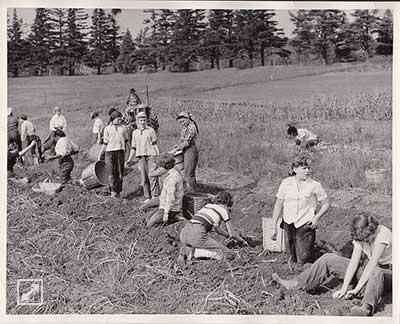Landscape Lenses
Physical Landscape : Soils
Soils are the interface between mineral geology and life. They are formed through the physical and chemical weathering of parent material (bedrock or surficial sediments.) The addition of decomposed organic material, air and water will further speed the soil building process. In some places like the tropics, soils have been forming for millions of years, but in a glaciated landscape such as Vermont, the most soils are a mere 13,500 years old. 
WWII Victory Garden at Rock PointNo matter how old they are, soils continue to develop as long as there are organic and mineral resources available. Some soils form more rapidly than others, and in some cases, such as soil formation in floodplains, it is one of the few geologic processes that we can observe on in our own lifetime.
Soil supports plant growth in several ways. It provides a substrate for plants to anchor their roots, and, depending on its composition, it supplies varying amounts of water, air and nutrients for the plant as well. Of the eight essential plant nutrients five are derived from soils. How much and which kinds of nutrients are available in the soil depends largely on the chemistry of the parent material. Soils that have a high content of clay or organic material tend to have the largest amount of biologically available nutrients. In contrast, soils that are mostly sand, gravel, or silt are more inert and provide fewer nutrients for plants and animals. In both cases, weathering is the process that causes the breakdown of material and makes the nutrients available to living organisms.
What soils form where and how they affect the landscape is a broad and complex science. Most soil scientists use a soil classification system that organizes all of the world’s soils into eleven orders. These orders are further broken down until they are finally split into families and series. The characteristics used to identify soils include grain size, moisture, existing soil horizons, mineralogy and sometimes temperature. Soil series are named after the location where the series was first described. As you become familiar with the soil series of your area, look for connections between soil type and land use.
Source: Rock Point Grounds- World War II Victory Garden
From Vermont Episcopal Diocese Archives